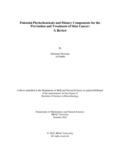| dc.description.abstract | Cancer is a global health issue that takes the lives of at least one in every six people
worldwide; it can originate in almost any tissue of the body, including skin. Skin, the
largest human organ, protects us from all the harmful and toxic components of
environment. Its exposure to the environmental stress events e.g. harmful chemicals,
ultraviolet ray, and viruses can cause skin cancer, including both melanoma and
nonmelanoma skin carcinoma. For skin cancer, currently there are a variety of conventional
treatment options available, all of which have drawbacks such as toxicity, multidrug
resistance, and high expenditure. On the other hand, the use of complementary alternative
medicine (CAM) with the intervention of phytochemicals and natural products has showed
less toxic effect in the treatment. This seems a more cost-efficient, effective, and safer
method for preventing and treating cancer. Using these bioactive compounds in in vitro
and in vivo testing for the treatment and prevention of malignant cell lines have shown their
role in regulating tumor promoting proteins, carcinogenic factors, and signal pathways
involved in cancer progression. These can help in promoting cell apoptosis, inhibiting cell
proliferation, angiogenesis, and metastasis, sensitizing cancerous cells, and boosting the
immune system. This review provides an overview of the potential phytochemicals
(including flavonoids, carotenoids, vitamins, sulforaphane, and resveratrol) in cancer
therapies, discussing their bioavailability, natural sources, molecular mechanisms of
action, and therapeutic potentials. | en_US |

